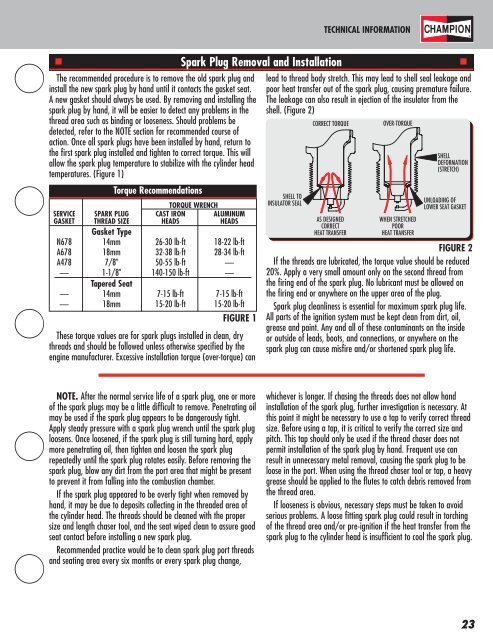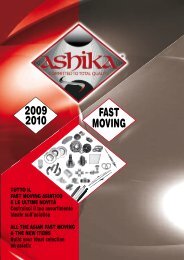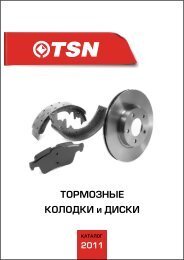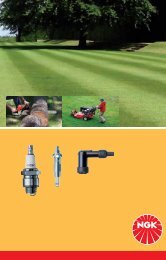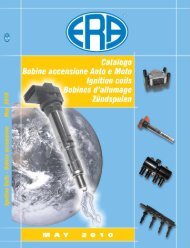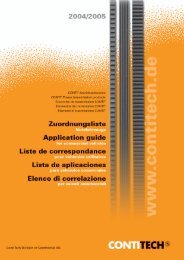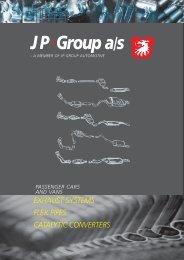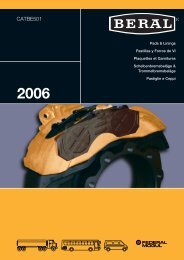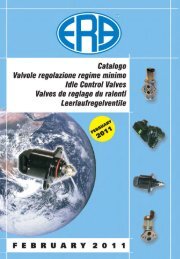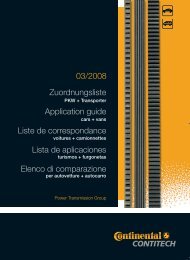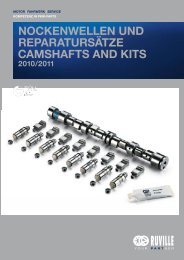THE WORLD'S FAVORITE SPARK PLUG.™
THE WORLD'S FAVORITE SPARK PLUG.™
THE WORLD'S FAVORITE SPARK PLUG.™
- No tags were found...
You also want an ePaper? Increase the reach of your titles
YUMPU automatically turns print PDFs into web optimized ePapers that Google loves.
TECHNICAL INFORMATION■ Spark Plug Removal and Installation ■The recommended procedure is to remove the old spark plug andinstall the new spark plug by hand until it contacts the gasket seat.A new gasket should always be used. By removing and installing thespark plug by hand, it will be easier to detect any problems in thethread area such as binding or looseness. Should problems bedetected, refer to the NOTE section for recommended course ofaction. Once all spark plugs have been installed by hand, return tothe first spark plug installed and tighten to correct torque. This willallow the spark plug temperature to stabilize with the cylinder headtemperatures. (Figure 1)Torque RecommendationsTORQUE WRENCHSERVICE <strong>SPARK</strong> <strong>PLUG</strong> CAST IRON ALUMINUMGASKET THREAD SIZE HEADS HEADSGasket TypeN678 14mm 26-30 lb-ft 18-22 lb-ftA678 18mm 32-38 lb-ft 28-34 lb-ftA478 7/8" 50-55 lb-ft —— 1-1/8" 140-150 lb-ft —Tapered Seat— 14mm 7-15 lb-ft 7-15 lb-ft— 18mm 15-20 lb-ft 15-20 lb-ftFIGURE 1These torque values are for spark plugs installed in clean, drythreads and should be followed unless otherwise specified by theengine manufacturer. Excessive installation torque (over-torque) canlead to thread body stretch. This may lead to shell seal leakage andpoor heat transfer out of the spark plug, causing premature failure.The leakage can also result in ejection of the insulator from theshell. (Figure 2)SHELL TOINSULATOR SEALCORRECT TORQUEAS DESIGNEDCORREC<strong>THE</strong>AT TRANSFEROVER-TORQUEWHEN STRETCHEDPOORHEAT TRANSFERSHELLDEFORMATION(STRETCH)UNLOADING OFLOWER SEAT GASKETFIGURE 2If the threads are lubricated, the torque value should be reduced20%. Apply a very small amount only on the second thread fromthe firing end of the spark plug. No lubricant must be allowed onthe firing end or anywhere on the upper area of the plug.Spark plug cleanliness is essential for maximum spark plug life.All parts of the ignition system must be kept clean from dirt, oil,grease and paint. Any and all of these contaminants on the insideor outside of leads, boots, and connections, or anywhere on thespark plug can cause misfire and/or shortened spark plug life.NOTE. After the normal service life of a spark plug, one or moreof the spark plugs may be a little difficult to remove. Penetrating oilmay be used if the spark plug appears to be dangerously tight.Apply steady pressure with a spark plug wrench until the spark plugloosens. Once loosened, if the spark plug is still turning hard, applymore penetrating oil, then tighten and loosen the spark plugrepeatedly until the spark plug rotates easily. Before removing thespark plug, blow any dirt from the port area that might be presentto prevent it from falling into the combustion chamber.If the spark plug appeared to be overly tight when removed byhand, it may be due to deposits collecting in the threaded area ofthe cylinder head. The threads should be cleaned with the propersize and length chaser tool, and the seat wiped clean to assure goodseat contact before installing a new spark plug.Recommended practice would be to clean spark plug port threadsand seating area every six months or every spark plug change,whichever is longer. If chasing the threads does not allow handinstallation of the spark plug, further investigation is necessary. Atthis point it might be necessary to use a tap to verify correct threadsize. Before using a tap, it is critical to verify the correct size andpitch. This tap should only be used if the thread chaser does notpermit installation of the spark plug by hand. Frequent use canresult in unnecessary metal removal, causing the spark plug to beloose in the port. When using the thread chaser tool or tap, a heavygrease should be applied to the flutes to catch debris removed fromthe thread area.If looseness is obvious, necessary steps must be taken to avoidserious problems. A loose fitting spark plug could result in torchingof the thread area and/or pre-ignition if the heat transfer from thespark plug to the cylinder head is insufficient to cool the spark plug.23


